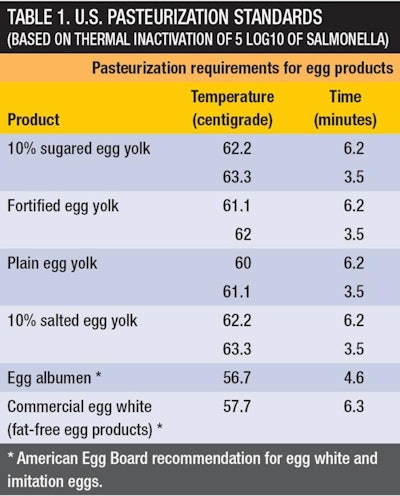
Newcastle disease and avian influenza (AI) are caused by heat labile, enveloped RNA viruses which, according to Dr. David E. Swayne, center director, Southeast Poultry Research Laboratory, USDA Agricultural Research Service (ARS), in Athens, Georgia, are relatively easy to kill. Swayne told the audience at the International Egg Commission meeting in Vienna that, “Avian influenza viruses are relatively easy to kill. It is just a matter of temperature and time, either in pasteurization or cooking.”
Some data existed which established the validity of using thermal inactivation to control Newcastle disease and AI viruses in eggs products. However, the data was limited to a few products: whole egg, liquid egg whites, 10 percent salted yolk and dried egg white. The World Organization for Animal Health (OIE) and the American Egg Board requested that ARS evaluate the effectiveness of pasteurization process to inactivate AI and Newcastle disease viruses in a wider range of egg product categories.
AI facts
AI viruses are bird specific and rarely cross from birds to humans.
“You have to have very close, intimate contact with a bird that is infected to contract avian influenza," Swayne said. "That usually happens in countries that have live poultry markets and almost all human cases involve direct contact with live poultry markets with infected birds, generally produced on small farms. Most cases have occurred in Asia and most have involved H5N1, a highly pathogenic strain.”
When chickens are infected with a low pathogenic strain of AI, their respiratory and digestive tracts tend to be contaminated with virus and the death rates are low. Hens infected with low pathogenic strains of AI can produce eggs with AI contaminated the shell of the egg, but not the interior. Swayne said, “We have never been able to find low-path AI inside the egg in experimentally infected chickens.”
Chickens infected with high pathogenic strains of AI can have all of their organs infected with the virus and they experience very high mortality -- as much as 100 percent of some flocks. Eggs produced by hens infected with high-pathogenic strains of AI produce eggs with internal and external AI virus contamination.
The surface proteins that define the strain of avian influenza are called hemagglutinin (H) and neuraminidase (N). There are 16 hemagglutinin subtypes and 9 neuraminidase subtypes. Swayne said changing surface proteins on the virus has little impact on the thermal stability of the influenza virus.
Newcastle disease
AI and Newcastle are heat labile enveloped RNA viruses. Newcastle disease has three pathotypes: velogenic (highly virulent), mesogenic (intermediate virulence), and lentogenic (nonvirulent). In rare cases, velogenic Newcastle disease virus can cause a mild infection in humans.
Newcastle disease virus is much more common in poultry throughout the world than is AI virus. Virulent Newcastle disease virus can be found inside the eggs produced by infected chickens. Chickens infected with either velogenic or lentogenic strains of Newcastle virus can produce eggs with virus contaminating the egg shell.
Pasteurization results
Swayne said the existing U.S. Salmonella pasteurization standards for egg products were used as a starting point to determine the time and temperature requirements for inactivating AI and Newcastle viruses (Table 1). He explained that the big difference between testing for inactivation of bacteria and viruses is that viruses won’t replicate outside a living cell, so you have to use tissue culture or embryos.
The pasteurization standards for fortified and plain yolk products were more than adequate to inactivate all AI and Newcastle viruses. Sugared and salted egg yolk had more-than-adequate inactivation for AI and lentogenic Newcastle viruses at the high and low pasteurization temperatures, but marginal inactivation for velogenic Newcastle virus at high temperatures. However, Swayne said there is approximately a 1 log10 inactivation during the temperature ramp-up phase, which adds an extra margin of safety for velogenic Newcastle virus at high temperatures.
One egg product category tested is referred to as “imitation egg products” or “fat-free egg products.” Swayne said that the imitation egg products tested in these studies contain egg whites. For the retail imitation egg products, the low temperature pasteurization standards were inadequate in inactivating AI and Newcastle viruses. Swayne recommended that producers of these products either use pre-pasteurized raw materials or pasteurize the finished product at longer times and/or at higher temperatures.

















